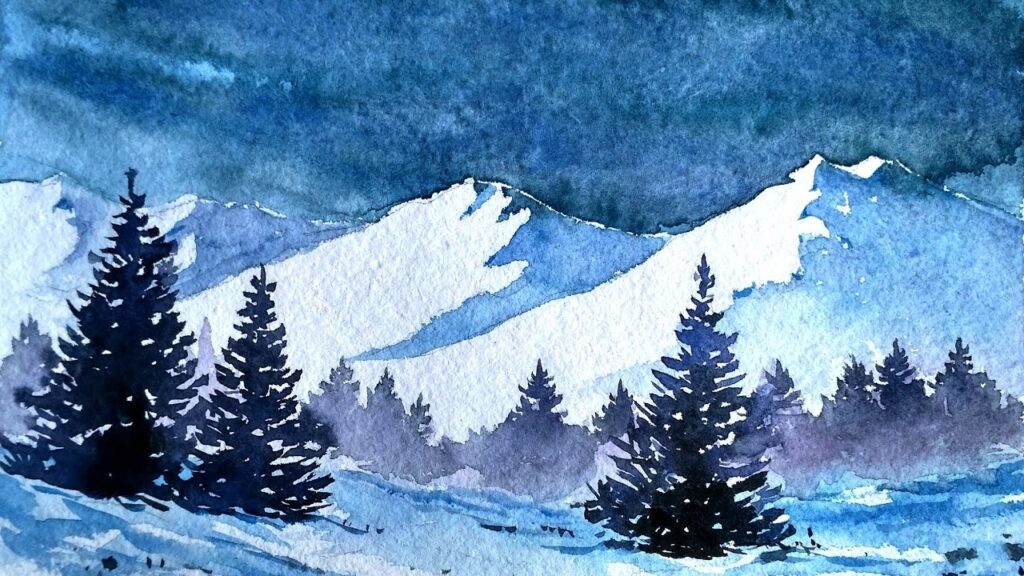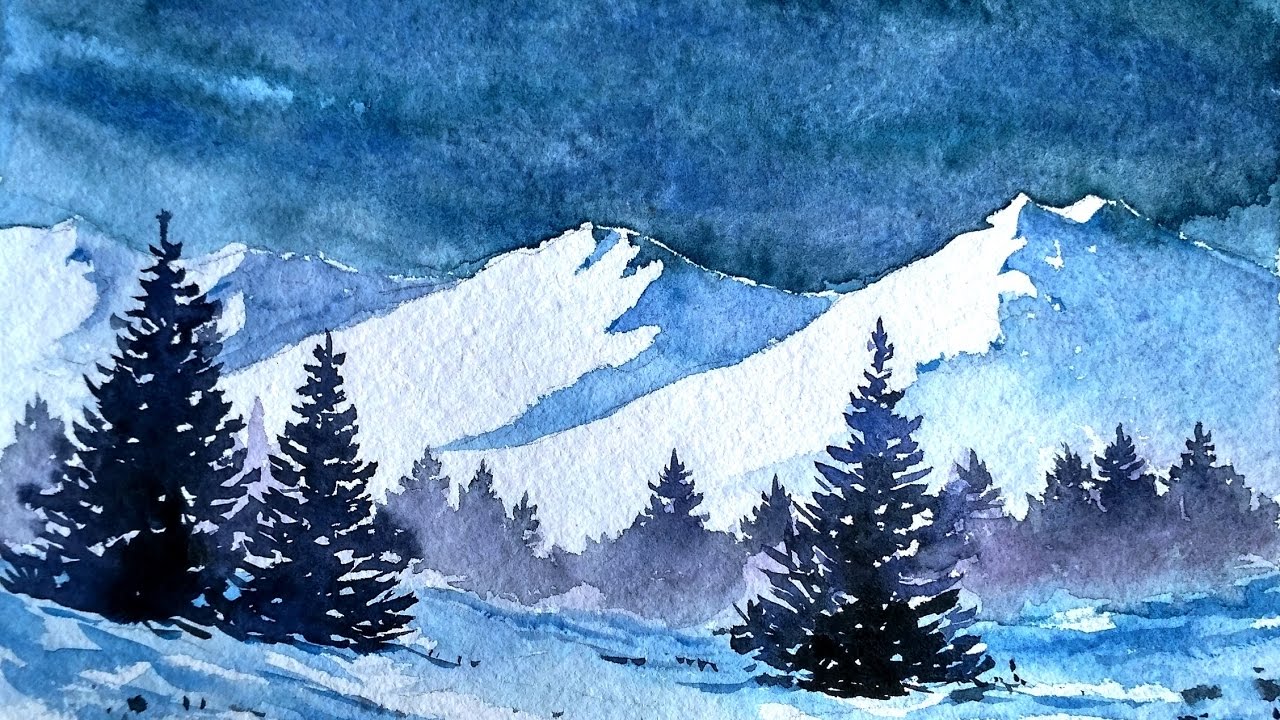
Unlocking the Beauty: A Comprehensive Guide to Watercolor Landscape Painting
Watercolor landscape painting offers a unique and rewarding artistic experience. Its translucent washes and vibrant colors allow artists to capture the subtle nuances and ethereal beauty of the natural world. Whether you’re a seasoned artist looking to explore a new medium or a beginner eager to learn the basics, this comprehensive guide will provide you with the knowledge and techniques you need to create stunning watercolor landscapes.
This article delves into the core aspects of watercolor landscape painting, from selecting the right materials to mastering fundamental techniques and developing your own artistic style. We will explore the properties of watercolor paints, the importance of paper selection, and the various brushes that can be used to achieve different effects. Furthermore, we will cover essential techniques such as washes, layering, dry brushing, and lifting, providing practical tips and exercises to help you hone your skills.
Understanding Watercolor Materials
The foundation of any successful watercolor landscape painting lies in the quality of your materials. Choosing the right paints, paper, and brushes can significantly impact the final outcome of your artwork.
Watercolor Paints: Pigments and Properties
Watercolor paints are composed of finely ground pigments suspended in a water-soluble binder, typically gum arabic. The quality and properties of the pigments used determine the paint’s transparency, staining ability, and lightfastness. Artist-grade paints offer higher pigment concentrations and superior lightfastness compared to student-grade paints, ensuring that your artwork will retain its vibrancy for years to come. Consider experimenting with different brands and pigments to discover your personal preferences. Some popular pigments for watercolor landscape painting include:
- Ultramarine Blue: A versatile blue with a slightly granular texture, ideal for skies and distant mountains.
- Cerulean Blue: A brighter, more opaque blue, suitable for depicting clear skies and water.
- Burnt Sienna: A warm, earthy brown perfect for representing soil, rocks, and tree bark.
- Raw Sienna: A lighter, more transparent brown, useful for creating subtle washes and highlights.
- Cadmium Yellow: A vibrant, opaque yellow ideal for depicting sunlight and foliage.
- Alizarin Crimson: A rich, transparent red that can be used to create a wide range of pinks and purples.
Watercolor Paper: Texture and Weight
The choice of watercolor paper is crucial for achieving desired effects. Watercolor paper is available in various textures, weights, and sizes. The texture of the paper affects how the paint flows and settles on the surface. Common textures include:
- Hot-pressed: Smooth surface, ideal for detailed work and fine lines.
- Cold-pressed: Slightly textured surface, suitable for a wide range of techniques.
- Rough: Highly textured surface, perfect for creating dramatic effects and capturing the ruggedness of landscapes.
The weight of the paper refers to its thickness, measured in pounds per ream (lbs) or grams per square meter (gsm). Heavier paper, such as 140 lbs (300 gsm) or higher, is less likely to buckle or warp when wet, making it ideal for watercolor landscape painting. Lighter paper may require stretching or taping to a board to prevent buckling.
Watercolor Brushes: Shapes and Sizes
Watercolor brushes come in a variety of shapes and sizes, each designed for specific purposes. Round brushes are versatile and can be used for both broad washes and fine details. Flat brushes are ideal for creating even washes and straight lines. Angle brushes are useful for painting corners and edges. Consider investing in a set of brushes with different shapes and sizes to expand your artistic possibilities. Synthetic brushes are a more affordable alternative to natural hair brushes and are often preferred for their durability and ability to hold their shape.
Essential Watercolor Techniques for Landscapes
Mastering fundamental watercolor landscape painting techniques is essential for creating realistic and expressive landscapes. Here are some key techniques to practice:
Washes: Flat, Graded, and Variegated
A wash is a thin, transparent layer of paint applied to the paper. Flat washes create an even tone across the surface, while graded washes gradually transition from dark to light. Variegated washes combine multiple colors to create a more complex and interesting effect. Washes are fundamental for creating skies, water, and other large areas of color in your watercolor landscape painting.
Layering: Building Depth and Dimension
Layering involves applying multiple washes of paint on top of each other, allowing each layer to dry completely before adding the next. This technique allows you to build depth, dimension, and complexity in your artwork. Layering is particularly useful for creating realistic foliage, mountains, and other landscape elements. When layering, it’s important to work from light to dark, as it’s easier to darken a color than to lighten it.
Dry Brushing: Creating Texture and Detail
Dry brushing involves using a brush with very little paint to create a textured effect. This technique is ideal for depicting rough surfaces such as rocks, tree bark, and dry grass. To dry brush, load your brush with a small amount of paint and then wipe off most of the excess onto a paper towel. Lightly drag the brush across the paper, allowing the bristles to skip over the surface and create a broken, textured line.
Lifting: Removing Paint to Create Highlights
Lifting is a technique used to remove paint from the paper, creating highlights and correcting mistakes. This can be done with a clean, damp brush or a sponge. To lift paint, gently blot the area with the brush or sponge, being careful not to scrub the paper. Lifting is particularly useful for creating highlights in clouds, water, and other reflective surfaces.
Composition and Perspective in Landscape Painting
A strong composition is essential for creating a visually appealing and engaging watercolor landscape painting. Consider the following elements of composition when planning your artwork:
Rule of Thirds: Creating Visual Balance
The rule of thirds is a compositional guideline that suggests dividing your canvas into nine equal rectangles using two horizontal and two vertical lines. Placing key elements of your landscape along these lines or at their intersections can create a more balanced and visually interesting composition. For example, you might position the horizon line along the top or bottom third of the canvas, or place a prominent tree or rock formation at one of the intersections.
Perspective: Creating Depth and Distance
Perspective is the technique used to create the illusion of depth and distance in a two-dimensional artwork. Linear perspective involves using converging lines to represent objects receding into the distance. Atmospheric perspective involves using changes in color, value, and detail to create the illusion of depth. Objects in the distance typically appear lighter in value, less saturated in color, and less detailed than objects in the foreground. Understanding and applying the principles of perspective is crucial for creating realistic and convincing landscapes.
Developing Your Own Artistic Style
While mastering fundamental techniques is important, developing your own artistic style is what will ultimately set your watercolor landscape painting apart. Experiment with different approaches, explore various subjects, and find what resonates with you. Here are some tips for developing your own style:
Study the Masters: Learn from the Best
Studying the works of renowned watercolor artists can provide valuable insights and inspiration. Analyze their techniques, compositions, and color palettes. Pay attention to how they use light and shadow to create depth and atmosphere. Some notable watercolor landscape painters include J.M.W. Turner, John Singer Sargent, and Winslow Homer.
Experiment with Different Techniques: Find What Works for You
Don’t be afraid to experiment with different techniques and approaches. Try using different brushes, papers, and paints. Explore various styles, from realistic to abstract. The more you experiment, the more you will discover what works best for you and what you enjoy painting.
Paint Regularly: Practice Makes Perfect
The key to improving your watercolor landscape painting skills is to paint regularly. Set aside time each week to practice and experiment. Don’t be discouraged by mistakes; view them as learning opportunities. The more you paint, the more confident and skilled you will become.
Conclusion
Watercolor landscape painting is a rewarding and challenging art form that offers endless possibilities for creative expression. By understanding the properties of watercolor materials, mastering fundamental techniques, and developing your own artistic style, you can create stunning landscapes that capture the beauty and essence of the natural world. So, gather your supplies, find a scenic spot, and let your creativity flow. Happy painting!
[See also: Mastering Watercolor Washes for Beginners]
[See also: Choosing the Right Watercolor Paper]
[See also: Essential Watercolor Techniques]

